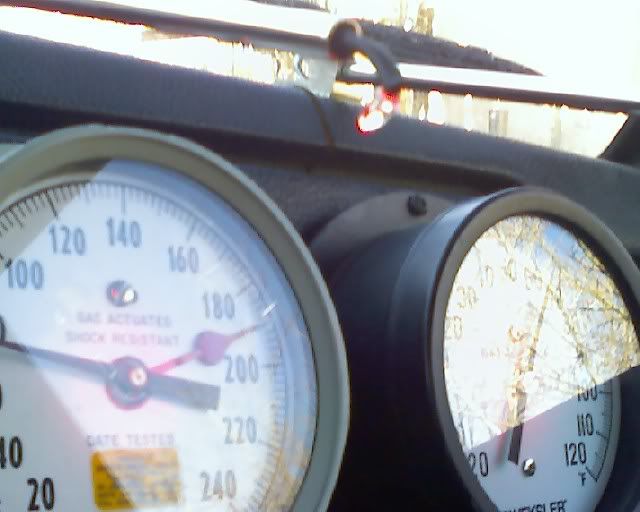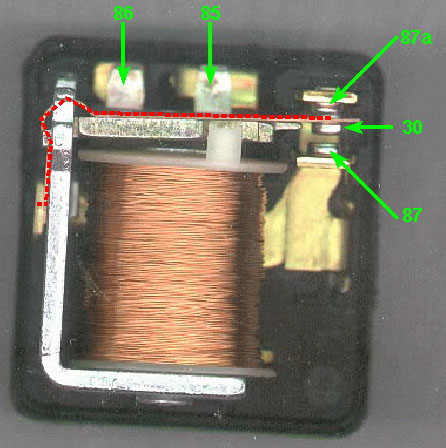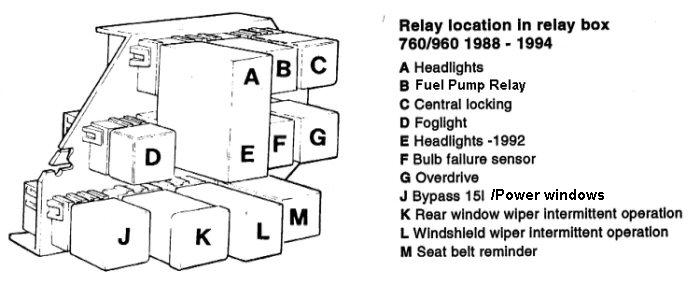|
|
|
The story: My wife drove her 760 to work several months ago without issue, but at the end of the day the car wouldn't start. I drove to her work and tried to get it started, but couldn't.
It turned over but wouldn't start, which means either fuel or spark, right? I get spark at the plugs but the plugs looked dry. After trying for quite a while I sniffed the exhaust and didn't smell any gas, so I assumed fuel.
I checked the relay (and resoldered it per directions from the FAQ, thankyouverymuch!) and it works fine (I watched it with the cap off).
I couldn't hear either fuel pump hum, so I figured I discovered the problem, and after reading the FAQ that one pump wasn't designed to work without the other, I assumed the one was dead and it overworked the other, so I replaced both of them.
Still no workie.
I scoured the FAQ again and think it might be the fuel pressure regulator? But the FAQ states to check the pressure and I don't have the valves to check the pressure.
Help? And if I can't get suggestions, can someone loan me a shotgun to put it out of its misery?
|
|
|
|
|
Okay, here's the update, and thanks everyone for your posts. I've tried just about everything up there, I think.
I couldn't find a connection for the in-tank pump so after a bit of mumbling I pulled the assembly out again and tested the power to it (12v, btw) and made sure it was working (it was).
So now what?
I assume that since it works, all the relays are fine, right?
Someone suggested a new ECU. I couldn't see anything anywhere (Haynes nor here) showing where it was, so finally looked on eBay to see what it was supposed to look like and traced wires down to the panel on the driver's side. Is that it buried behind all those wires? And *damn* it's expensive.
I don't have a pressure release valve on the fuel rail to check for pressure. I'm getting spark to at least one plug.
Help?
|
|
|
|
|
Even with a dead intank pump, the car can still run on the main. If the main is dead, it won't start. Even though it turns over, doesn't mean the battery is putting out enough voltage to fire. Volvos are funny that way. Time to get back to basics.
Do you have good bright spark? If so, ignition should be good.
Are the plugs wet or dry after you attempt a start?
Compression?
And spark at the right time. Had an 85 that was 6 teeth off, wouldn't start.
Have you jumpered the fuel pump relay and see if it will start?
You mentioned whine in Radio suppression relay. Really doesn't have anything to do with the radio. Just a crap name that volvo gave it.
Alot of these things are covered in the FAQs.
--
Post Back. That's whats makes this forum work.
|
|
|
|
|
"Do you have good bright spark? If so, ignition should be good."
Um, it seemed bright. I could see it quite well in the light of day. I'm not sure how to quantify it.
"Are the plugs wet or dry after you attempt a start?"
After I attempted the start, the plug I pulled was not wet. I've pulled plugs before after trying to start a car and seen how soaked they can get. The one plug I pulled was not wet. Perhaps I should turn the car over for several minutes and see how the plugs look?
"Compression?"
I haven't checked the compression.
"And spark at the right time. Had an 85 that was 6 teeth off, wouldn't start."
I could see how that would screw things up, but is that something that could go from "fine" to "not start" within a few hours? I have a timing light, but would that even work without the engine running?
"Have you jumpered the fuel pump relay and see if it will start?"
No, and not sure how to do that. But as I stated above, both fuel pumps are working (and are brand new).
"You mentioned whine in Radio suppression relay. Really doesn't have anything to do with the radio. Just a crap name that volvo gave it."
Ah, good to know. I mentioned it only because from what I read in the FAQ, Volvo instituted these because of complaints or radio noise that is related to the engine's RPM. I thought that maybe the reason my radio had that noise was because of a faulty RSR.
|
|
|
|
|
Here's how to jumper the relay.
http://www.brickboard.com/FAQ/700-900/EngineFuelinjection.htm#FuelPumpandFIRelayDiagnosticTests
Just put a timing light on it and have someone crank it. See what you get. Did you remove the plug wires and reinstall? You wouldn't be the first to put them on wrong.
If your plugs are dry and fuel pumps work. Suspect injectors are not opening. RSR. That can be jumpered also.
--
Post Back. That's whats makes this forum work.
|
|
|
|
|
There have been recent posts by "Lucid" and others giving instructions on how to apply 12 volts directly to the RSR relay. Click on Lucids name and see his recent posts to find the instructions. He also gives an excellent walk thru of the diagnostic process. If your plugs are dry after repeated cranks then it sure sounds like the RSR is the place to start.
|
|
|
|
|
I bet there is a break in the wires going to the fuelpump unit??
|
|
|
|
|
New discovery:
I have the FI relay cap removed but the relay is in place. I happened to touch it and heard some clicks so I started to check it out a little closer.
With the key turned off, interestingly enough, if I close the circuit on one of the relays (there's two in there) then I can hear the main fuel pump whir.
If I hit the other circuit, I hear a click under the hood, but I don't hear the in-tank one at all.
I just replaced both fuel pumps, as I stated. I replaced the panel where you access the fuel tank, but I haven't replaced the seat, so it seems to me like I should be able to hear something. I'll have to wait until tomorrow to get someone to turn the key while I listen at the open fuel tank, I guess.
So, now what? If I don't hear the rear pump, now can I test it? Do I have to remove the pump again? I didn't see any connectors or anything within two feet of the assembly, so I don't know how to try to get power to it (or test for power there) without stripping back the wires or something.
|
|
|
|
|
hello
follow the in tank pump wires through the rubbe gromet, there is a connector.
|
|

|
|
Hi.
Power the pump and try to start the car.
Goatman
|
|
|
|
|
Your reply is vague.
If you mean hold both relay things down, I did that and it didn't work. Besides, as I stated, the relays themselves work, so I'm not surprised.
If you mean get separate power to the in-tank fuel pump... how?
|
|
|
|
|
I was just passing by and see you are at your wits end.
I think you have a fuel problem but you are thinking with the relays and harness in your way.
I think you should do either of two things.
Open the fuel line to the fuel rail and put the input line into a jar and verify that you are pumping gas when cranking.
Take about twenty five feet of wire and run it to a connector closest to both pumps and power them both up and check for fuel as above. It could be under a seat, or in the trunk. There has to be a junction some place through the body.
You might just have a bad ground. Pumps or relay connections. Go straight from the battery or take it back there if you don't have enough wire. Make it run if they are good or find out if there not.
There may be a way to do this by jumping fuse terminals but I don't know where or for sure that if could be done on 700 models. I'm a 200 owner. You might have to research that.
Just think bare knuckled or with your gloves off, might be another term.
Phil
|
|
|
|
|
Twice I have had no start problems same as yours.
Once it was the fuel injection relay under the hood. The relay attached to the left wheel arch. The one that can be swapped with the fan relay.
The second time no start problem but turning over it was the ECU. Yep. The ECU. Swapped the ECU and it worked. Bought two online on eBay about $110 each.
|
|
|
|
|
To determine if the pump/pumps work.
http://www.brickboard.com/FAQ/700-900/FuelSystem.htm#FuelPumpandFIRelayDiagnosticTests
Start back with the basics. Fuel, compression, spark and spark at the right time.
--
Post Back. That's whats makes this forum work.
|
|
|
|
|
You do not seemed to have positively establised that your fuel pumps are running. Put your hand on the main pump while cranking, you can feel and here it. Listen in the gas tank for the intank. If there is lots of gas in the tank the main will pull it through even if intank is dead. You can crack open the fuel rail connection and see if fuel squirts out at high pressure, crude but tells the main pump is working.
--
David Hunter
|
|
|
|
|
If RSR is bad, injectors won't open thus no fuel to the cyclinders.
http://www.brickboard.com/FAQ/700-900/EngineFuelinjection.htm#Radio_Suppression_Relay
--
Post Back. That's whats makes this forum work.
|
|
|
|
|
It wouldn't surprise me if this was the culprit considering that the stereo always has a whine going through it (no, I don't listen to country music) that coincides with the engine speed. I've tried to trace the problem before but I hadn't seen that link and assumed that the relay was in the passenger compartment with the others.
You're obviously knowledgeable about this: how do I determine posts 3 and 4? I clearly can't take apart this relay like I did the others to resolder it (can I?).
I just checked NAPA's website and they don't list this part, but the FAQ states that the cooling fan relay will work as a test. Soooo, can I just buy one of those and put it where the RSR goes?
BTW, as if you didn't already know this, Haynes SUCKS for this stuff. I love this board...
|
|

|
|
Hello,
Here is the part:
http://www.eeuroparts.com/Main/PartDetail.aspx?id=1323592
You should remove the fan relay on your car and then switch it with the radio relay in order to check if there is a fault.
Goatman
|
|
|
|
|
'kay, I swapped the two relays and it still won't start.
Answering my question about soldering, I accidentally removed the silicone from the original RSR, so I guess it does come apart and now I need to put some caulking back in its place.
grrr
|
|
|
|
|
I tried that once on a no start problem and I thought that wasn't the problem. After checking everything else and going bald. It was suggested to me by another Brickster to manually check the relay/circuit by first using a test light at the fuel injector wiring harness (green wire), crank, and if no light then remove RSR and jumper the two heavier gauge wires and try cranking the engine again. If still no start then that is not the problem. You will need to fault trace before the RSR.
Your other relay may be bad as well, don't assume that it is good.
|
|

|
|
Hello,
Please check for voltage at the fuel pump relay contacts.
Goatman
|
|

|
|
Hello,
You say that you watched the fuel pump relay operate, that is only a guarantee that it works mechanically. It doesn´t prove that it works electrically.
You need to check for 12V at the fuel relay contacts. (not the relay coil connections, but the contacts, #30 and #87).
if you have 12V to earth at both contacts when the relay is on, then you need to check for voltage at the fuel pump itself.
Goatman
|
|
|
|
|
Okay, how do I find these?
Looking at the prongs on the relay, I see 87/2, but where's 30?
And do I pull the relay and try probing the socket?
Edit to add: I assume I turn the key on, but do I need to do anything else?
|
|

|
|
Hi,
You want to probe the contacts of the relay. There should be a diagram on the case. I would remove the cover of the relay and do it that way.
Goatman
|
|
|
|
|
Thanks, mate. I'll go do that now.
But where do I find 30?
|
|
|
|
|
On 87/2, it showed 15v while turning over the car, then when I let up it went to 16v for a second then stopped when I let go of the key.
Oh, and this was with the cover removed from the relay and probing the internal part of the relay.
|
|

|
|
Hi
If indeed you have 12V at 87 (not 87a) when you are cranking AND you have a resistance of about 100 ohms from 87 to chassis ground with the ignition off,
then you can be reasonably assured that the fuel pumps are getting power.

Click on the picture for more info on relays
|
|
|
|
|
Ah, now I get why I didn't understand.
My relay looks nothing like that. It has two relays inside of it, and it's 87/1 and 87/2 instead of 87 and 87a. I don't see a 30 in there, but I'll go look.
My setup is like this:

|
|
|
|
|
When I checked for spark, I had my wife turn the key while I grounded a plug that I'd pulled out.
A few puffs of gas vapor poofed out the hole, so it's gotta be getting *some* fuel. That's part of the reason I assumed the FP thing.
I'll check out your link. Thanks for the response.
|
|

|
|
Hi,
When gases are compressed, they heat up. When the gases expand again, they cool off. When gases cool off, sometimes things like water and oil that are dissolved in them condense and appear as vapor.
You really need to check for voltage at the fuel pump. Do not assume anything, that is how problems are able to hide from you.
Goatman
|
|
|
|
|
Okay, Mr. Goat, how do I check voltage at the in-tank unit? Pull it out of the tank again?
|
|

|
|
Hi,
Me being so lazy, I would measure the resistance of the pump windings at the relay socket, that would verify that the connection is indeed intact to the pump itself. I would then obtain a voltage measurement at the relay contacts, this would then prove whether the pump is or is not getting electricity.
Goatman
|
|
|
|
|


